
MARS SOUTH POLAR GEYSERS
ARE LIFE
Report #087
May 21, 2005
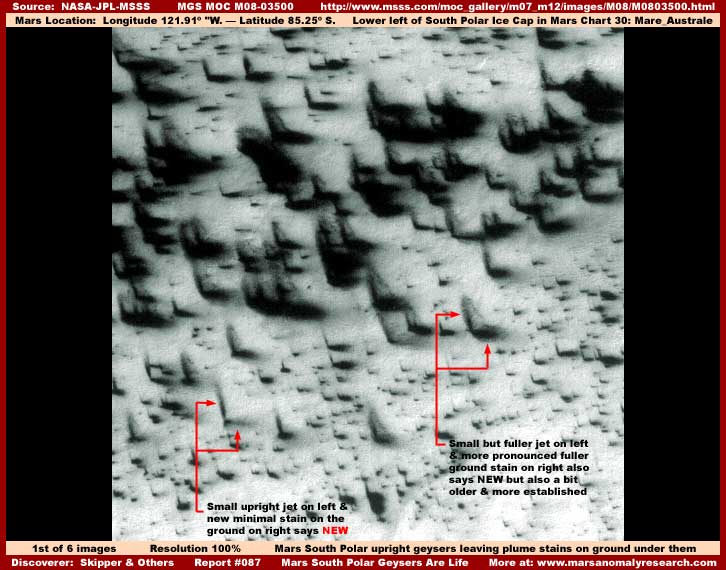
Here I go getting overly ambitious again and perhaps crossing boundaries as some may see it. Maybe so but, in my opinion, it takes only observational experience looking at this official science data (in my case tens of thousands of images) by a reasonably thoughtful person with some common sense to make reasonably accurate interpretations. Ultimately, you must judge for yourself.
Also, this is one of those situations where I have sat on and held back this evidence for several years now getting too used to the idea that "most researchers" cannot find this kind of evidence. I put off reporting on it because reporting on it is difficult in first making and then simplifying the connections in this kind of short reporting style. So I kept thinking that I would get back to it and maybe do more research and develop some better visual evidence. However, I seemed to continue to be bogged down with more and more time demands with less and less time to get back to anything.
Well putting off and procrastinating is of course rarely successful and the term "most researchers" does not mean all. In this case it turns out that I was wrong and sort of got stampeded into doing this report on this subject right now because it just recently came to my attention that others were beginning to find and discuss this particular M08-03500 image's geyser evidence, apparently in forums. So, even though they apparently have not figured out the real implications yet, I've decided to put in my two cents now rather than continue waiting on better research material to work with and chancing others may well figure this out.
The above first image sourced from the MGS MOC M08-03500 strip is the main one other researchers have apparently discovered. In this view it demonstrates the evidence as seen at official 100% resolution allowing a wider view of more of the evidence. The geyser/spout/jet ejecting vertically up and out of the ground evidence is represented by the vertical upright dark geyser column and the dark area projecting out at right angle from the base of the column is not shadow but a dark plume stain on the ground.
Future researchers should be aware that, although it doesn't look that way here so much, when there are very many of these present in a stronger wind stretching out the ground stain into a thinner slightly longer stain line, the combination of the vertical column and the ground stain forming two right angle dark narrow lines generally all oriented in the same direction is easy to confuse in this 2-dimensional imaging with a partially buried squared rocks casting dark narrow shadows on two sides and can even look very much like broken up paving in the Mars landscape. However, the geological rock look is not real and is an illusion.
Further, be forewarned that this type of evidence is much more often than not seen at a camera angle where the narrower vertical jet dark column is visually superimposed on the wider tear drop shaped even darker ground stain. This causes the two separate pieces of evidence to visually blend in together and appear as a single dark blob. Even so it is the same evidence and more and more experience at looking at this will result in better and better recognition of it.
As you can see in the above first image, there are small lone vertical ejections and larger lone ones as well as multiple ones close to each other that combine. Even in this fairly distant view, it can be seen that the larger darker stain areas on the ground seem to be growing and getting fatter with many fine tendrils branching out not only across the ground surrounding it but also upward. As you will see confirmed in subsequent imaging here in this report, this is a significant characteristic factor in what is going on here with these dark spots. It is a characteristic of life and growth rather than simple water alone or chemical reactions or geological activity.
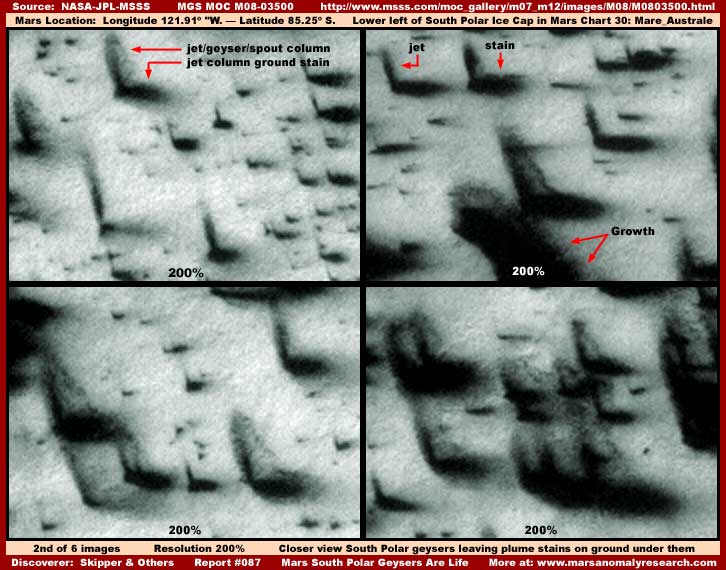
The above second four part image represents a closer view of primarily the ejecting jets and their ground stains from the same M08-03500 strip. Note that some of the small jets appear to be more liquid in nature while the larger older ones appear to be more heavy bodied with the presence of branching dark tendril forms extending at right angles out from the vertical jet column as well as from the larger dark ground stain area. Further, the bigger they are, the more this is true. This to is another very important characteristic of this evidence.
In the upper right scene in the above four part image, note the large dark mass pointed out by two red arrows in the bottom center of the image pointed out by a "growth" text label. Note the many fine branching tendrils but the absence of any visible geyser or jet associated with this object. This representative sample as well as many others like it not shown here demonstrate that the jets are prolonged and grow larger as time goes by but ultimately are temporary and the taller spewing outward aspect of the vertical jets disappear once their purpose is served. This to is another significant characteristic factor of these dark spots.
It is my interpretation that what is being ejected under pressure is not water alone or chemical or geological activity, it is from a now rapidly growing and expanding underground pocket of water based nutrient soup teaming with a great many dark color colony life forms. Each form is dark color so that each alone immediately starts absorbing solar radiation as does the accumulated mass of them piling up on the ground when exposed on the surface. As their above ground numbers increase, they make connections with other forming linked chains and the appearance of rapid growth into a greater above ground branching form that expands the dark ground stain laterally and to some extent vertically.
These scenes and this evidence is more distantly seen than one might suspect and that means that even the smallest of these are actually quite large forms. Naturally the black and white imaging as released to us does not permit color identification that would provide additional clues but it is clear that this evidence characterized by very dark strong light absorbing colors.
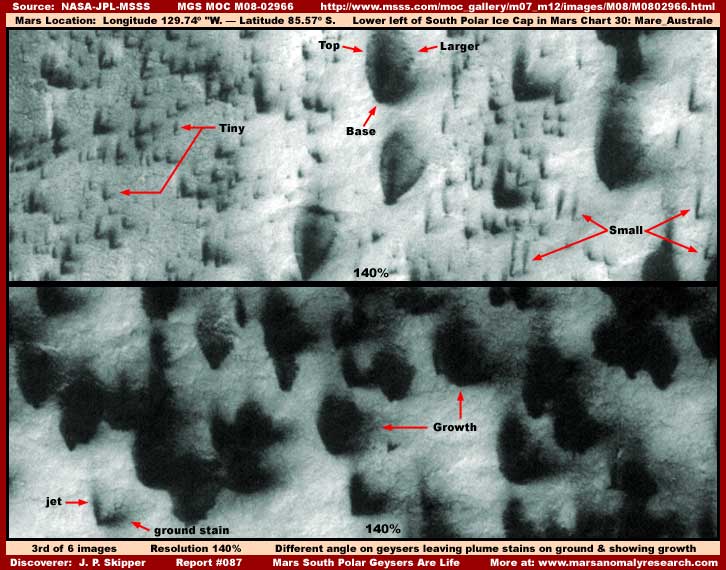
The above third over and under split screen image is of evidence drawn from the different MGS MOC M08-02966 strip. This again demonstrates a representative sample confirming the same type of geyser/jet evidence in the same general nearby area but from a different data source. However here, although the ejection column is still vertical, the angle of the ground stain as per the prevailing wind direction is slightly to the right and behind the jet column at this camera angle. This blends and confuses the distinction between the vertical jet column and the horizontal ground stain as they visually overlap and merge together. In the upper view, this visual confusion is most true of the larger evidence with very large ground stains while the smallest newer jets with much smaller and newer ground stains are more informative revealing this visual angle confusion.
This characteristic of camera angle dramatically affecting the identification of this type of life evidence is very important. That's because a great deal of this evidence in the science data imaging is impacted by this problem and that is also why a lot of researchers have not made the connection between this often times visually different looking evidence, that it is actually the same, and thereby sense of what is really going on here. The apparent visual differences encourages interpretative examination to miss the true closer relationship. One purpose of my reporting here is to reveal this recognition problem so that more in depth researchers with more time and inclination can take the ball and run with it in depth beyond what my short reporting style can accomplish here.
In the above third image, the lower split screen view demonstrates from the same strip mostly all larger denser and thereby darker and a little longer established evidence where it is now even harder to differentiate between the vertical jet column and the horizontal ground stain. You'll note in the lower left corner that I did include in the crop a smaller newer jet and its ground stain pointed out with red arrows that clearly demonstrates both the separate dark vertical jet column and the horizontal ground stain plume just to be sure that there is no confusion that this is all the same evidence whether large or small.
The larger mass evidence in the lower view demonstrates that the ground stain remains and dynamically grows while the vertical jet plume may diminish and/or at least subside and visually merge into the growing and elevating dark ground based mass. Note that here again, as the larger dark masses begins to thicken and grow, the fine branching tendrils also become more visible and characteristic. This is how the earlier stages of this life form operates. It initially exists below ground where it grows and expands in a nutrient soup water based liquid pocket probably in trigger reaction to the increased or diminishing presence of water underground in the terrain and prevailing winds above ground. The presence of or diminishment of the underground water is probably seasonal as are the prevailing winds making for conditions that trigger explosive transformation to a surface life form.
When these conditions are right, it sets in motion an explosive spurt of growth in the nutrient soup below ground pocket. The explosive growth fills and creates pressure in the pocket confines resulting in a controlled breach to the surface in growing geyser/spout/jet form. I suspect that dry and light weight propagation spores are initially launched into the prevailing wind to spread far and wide in the initial stages of the jet.
Later, as the prolonged process continues and intensifies, the dark color heavier bodied colony individuals are ejected via liquid media (water) fairly high in the air above the terrain surface where the prevailing wind spreads them into a plume stain piling up on the ground nearby but not necessarily right at the base ejection point. As the explosive growth continues below, so does the colony form eject more and more material increasing the size of the vertical jet column and of course the size of the ground stain. This is the process we see in action in the first three images in this report.
The individual colony life forms collect together rapidly linking into chains building a dense tangle of the branching fine tendrils both on the ground as well as from the vertical jet column. So what may have started out as a below ground aquatic life form now is transforming itself into a above ground atmospheric collective life form that continues to grow and expand as such, at least up to a point. The ejection onto the terrain surface and transformation to an above ground atmospheric life form may be an adaptation of an original aquatic form (like colony coral) to increasingly dryer conditions developing over eons of time. The deployment of the very dark but relatively fine branching tendrils, especially even out from the growing and prolonged vertical jet columns you can see above, suggests very rapid colony activity.
In such a collective, as with the many various forms of coral, the structure of the above ground form must allow all individual members of the community to be exposed to air and incoming nutrient sources on the branching surfaces. That means no thick inner structure where live individuals are sealed within an interior body away from the outer surface areas requiring internal plumbing (like ourselves) to carry nutrients to those in the interior. The result is the tangle of branching tendrils design that maximizes surface area and yet allows air to pass through the entire main body mass. So the structure as a whole acts as an air sweep very similar in basic design to how Earth coral operate in their ocean currents.
In the beginning, the out pouring of the great many colony individuals via the jet and their accumulation on the ground stain builds the above ground branching tendril structure mass and so initial growth to larger size from minimal beginning origins occurs in this linking chain manner. However, once the prolonged jet out pouring is over, the mass then continues to grow via death and rebirth building on top of the bones of those who have gone before. So the interior supporting branching structure gets larger and more massive as it builds/grows outward over time. The colony is growing from a fixed ground anchoring point but spreading growth may eventually overlap with nearby colonies doing the same thing. However, a characteristic of this life form is that each colony continues to maintain its own individual collective identity under normal conditions and does not normally mix or merge with others.
The basics of this combination of below and above ground survival strategy may have started off as a defensive measure combining with a propagation strategy by the colony faced with world wide increasingly drying conditions over long amounts of time. This particular area not too far out from the South Polar Cap, as I have reported on several times, may be influenced to some extent by both decreasing dry and increasing water seasonal flooding conditions. That is obviously not favorable to a aquatic only species survival in the dryer times. The lowering of the water levels may have gradually grown severe enough in the driest times even below ground that this may have triggered the evolution and transformation of an above ground dry conditions survival strategy form by a very tough colony life form determined to survive.
Take for example the very dull non reflective dark light absorbing color of this particular life form. The very dark mass may look solid in this poor quality satellite imaging but it is almost certainly a dense tangle of branching tendril forms and we can see that only at the mass's outside edges where the dark tendrils thin out and become a little more visible against the lighter color reflective terrain background. The prevailing wind (a key factor) is probably colder at the time of year this life form's above ground transformation flourishes. The cold air currents carrying dust particles with chemical nutrients in them passing though this tangle of dark fine solar energy and heat absorbing mass that would probably precipitate water molecules right out of the air collecting on these branches keeping the whole mass generally damp and feeding the individual cooperatively acting colony forms.
When one thinks about it, this is very similar to colony coral life works underwater in our Earth seas. They attach to a anchor point in shallower waters where solar energy is available enough through the water layer, work cooperatively to achieve a greater collective physical often branching form, and then strain out the nutrients carried past and through their forms by the water currents. Their propagation is via spores ejected out in the water current all at the same time. In our Earth experience coral colony life does not change but then that no doubt has more to with the fact that in more stable environmental conditions it doesn't need to either in order to survive. A changing environment steadily but gradually putting ones back to the survival wall is a powerful incentive for adaptation, especially if enough time for adaptation is involved.
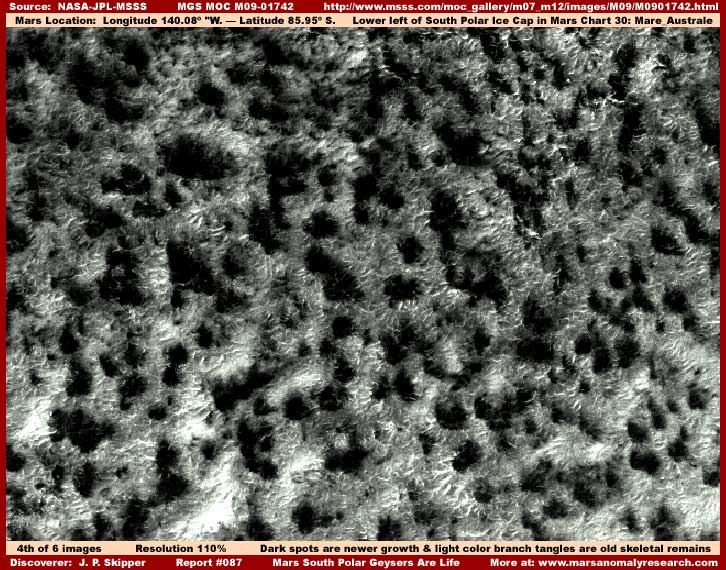
Now here in the above fourth image drawn from a different sample MGS MOC M09-01742 strip is a very different looking scene. It is representative of many such scenes. The dark spots you see are the same type of growth evidence presented here in this report. A closer examination of the original science data image and down its length will confirm the presence of the same more recognizable geyser/jet and ground stains in the image to help you in this regard if you have any such questions.
However, the main thing I want you to do is take special note of what kind of lighter color background these dark spots exist on. It looks very much like a tangle of roots, limbs or branches. That's because that is exactly what it is. Note to how thoroughly dispersed these dark spots are on this background. This evidence is in the same area and it, like the dark spots, are common in this area with this imaging being just a representative sample.
In the above fourth image, we are looking at this same newer stage colony life forming literally on the mature bones of their same type predecessors. At some point in the past, these mature well established colony branching shape forms flourished in this area literally carpeting the terrain. At its peak, we could not have seen much of anything identifiable because it would have just been a merged intermingled very dark light absorbing mass. I have seen a lot of this kind of evidence. It may be that flood conditions submerged this above ground air adapted survival form destroying it leaving only a field of skeletal remains of its now mature and enlarged branching forms. If so, it did not destroy the underlying aquatic below ground form and this is now reestablishing itself in its above ground survival form in this field of bones. In other words, individuals die but the colony whole survives.
It may be that this happens only occasionally but it may happen annually and seasonally, depending on the area involved. I suspect that the seasonal dry and flood water conditions I have previously reported on around the South Polar Cap have over the eons created an environment that favors highly adaptable life that can grow and flourish very rapidly taking advantage of the temporary presence of surface water. This concept has been suggested by independent telescope observational data demonstrating very rapid annual green growth outward from the South Polar Cap region and its later retreat back. A life form having both a aquatic below ground and above ground air adaptation stage of development dual survival strategy in place would fit into these kind of dynamic and fluctuating conditions very well.
You should also be aware that the above fourth image in this report is of a unusually large file size. As I've reported before, this usually means that the graphics software is counting a great number of hard objects in this scene. I'm assuming that this is the densely packed hard skeletal branching remains of the previous densely packed field of life as seen in the above image.
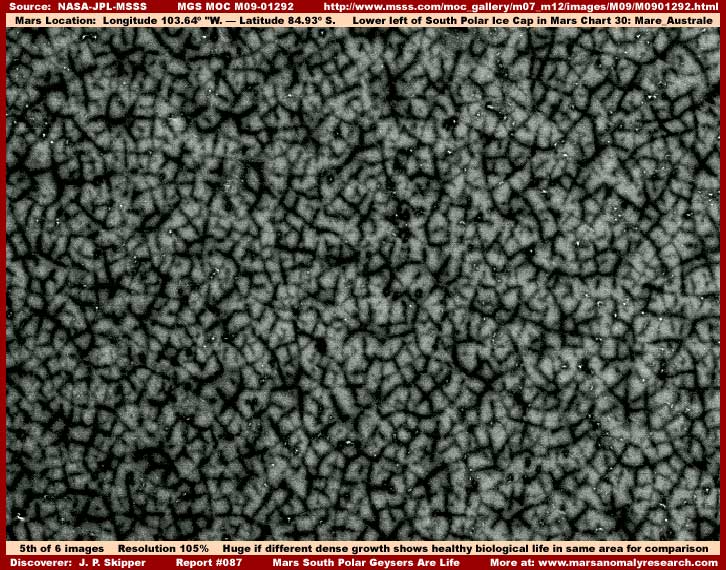
The above fifth image is drawn from yet another different official science data MGS MOC M09-01292 strip. The official strip information is washed out down the strip's length obscured with too much light color over saturation and did take some work to clarify and bring out the evidence you see above. Further, there is a network of joining ragged edged thin white lines (not shown here) in the lower part of the strip that does not conform to the ground contours suggesting that they may have been artificially introduced and may be image tampering. Just thought you might like to know what to expect if your go to and examine the original data strip.
Yelp, as you can see, here again the above fifth image evidence is considerably different looking than that otherwise presented in this report. I am satisfied that it represents dense thick biological life of some kind on a planet that isn't suppose to have any such thing. It is in the same general area as the foregoing evidence here and, despite the striking visual physical differences between this and the other evidence presented here, there is a relationship between this larger mature above ground life form and the other evidence that I have been reporting on in this report.
For starters it is basically the same evidence shown in the 9th image of my fairly recent Report #085 titled "Mars South Polar Biological Life: Part 3" located on the lower left edge of the fairly nearby South Polar Cap. However, this evidence is also almost identical to the evidence in my older 2001 Report #021 titled "Huge Fungi Growth in South Polar Region" located well out from and upper right far away across the opposite side of the South Polar Cap and, after all this time, I'm finally getting around to making that connection as implied in that older report.
In that older 2001 Report #021, you will see again different stages of development of this evidence occupying very high and steep ridge tops whereas the evidence in this report appears to be on fairly level terrain. I suspect, as I reported in 2001, that both types of evidence have the same origins in the same highly adaptable colony life form. In that older report you will find a little of the same beginning stage geyser vs. ground stain evidence on steep slopes as well as a lot of the same but even larger size branching tendrils stage evidence, and finally the same gigantic mature form closed over the top surface evidence as in the above fifth image.
I believe that all of this life evidence is the same type of life with the same origins regardless of how different it looks, just seen at different stages of development adapting to differing environmental conditions. Propagation is via a general broadcasting of spores in great numbers on prevailing winds and where any of those spores comes to rest and finds itself is determined mostly by chance. Success is determined by the sheer broadcast numbers insuring that some favorable conditions in some areas will be found. The conditions at any one location may be not favorable, only partially favorable or outright favorable. The visual look of the life form is determined by its adaptability, the conditions that it finds itself in, and the stage of development it is able to achieve in those conditions.
For example, landing on a fresh ice mass of mostly frozen water without much in the way of sediment nutrients in it inhibits above ground transformation development. The result is a dark low level furry spot that can't achieve a full above ground transformation and the colony remains in a basically halfway state aquatic form that exists as a very dark spot on the surface of the ice. It can't develop much beyond that stage because the ice is mostly only water with insufficient minimal nutrients necessary for any kind of explosive growth surge. As evidence of this please take a look at my Report #057 in 2003 titled "Water Ice Masses: Ecology's of Life." There you will see evidence of these very dark but no real elevation spots traveling from the ice mass center areas to the outer edges and collecting there. They are carried to the edge by general melt water conditions that cause the entire ice mass to partially melt, slump and develop a lower profile. In other words, a very unstable environment for this life form.
Likewise when older more stable ice masses also carry within them very much sediment, the colony is able to achieve both a surface aquatic existence in surface nutrient liquid water pools and/or a sort of low elevation inhibited but still spreading above ground transformation depending on the area of the ice mass they are on and the degree of sediment in the ice in that area. In the same Report #057, you can see the evidence of these clearish but still dark nutrient pools on an older ice mass in my fourth image.
There note that each dark tinted pool has a darker spot within it. This is the access point to the initial below ground (ice) developmental pocket area that eventually breached to the surface at this point basically at the bottom center of the now surface nutrient pool. However, the presence of enough surface melt (their dark forms absorbing solar heat help with this) water eliminated the survival tactic of needing to transform to a full above ground atmospheric form, so that stage of development is arrested demonstrating both high adaptability and versatility.
The ideal conditions for colony life form's full above ground transformation and development and thereby visually coming to our attention in this distant satellite imaging appears to be its presence in richer soil that has enough below ground water or ice to provide for the development of the below ground nutrient soup pocket in confining conditions strong enough to resist explosive growth and provide for controlled expansion and ejection to the surface. Too much water or ice impedes the above ground development transformation process and even the need for it while permanently dry conditions preclude it all together.
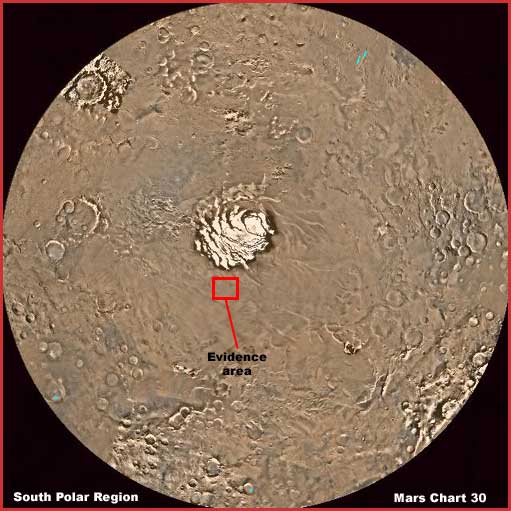
The above sixth image is of the South Polar Region in Mars Chart 30: Mare_Australe. The red box outline indicates that area from which the evidence here in this report was drawn. The visual evidence presented in this report is not meant to fulfill the role of a complete or conclusive treatment, only representative samples that point the way. This is a huge subject with far too many image strips to link to here but they are ready and waiting for detailed examination for anyone interested enough to search for it. The red outline in the above image indicates where to start in the South Polar Region with the various image sets and work out from there for those interested in pursuing this particular biological life research in detail.
A adequate treatment of this subject matter would take volumes of work and a huge number of space consuming images. That just isn't practical in this shorter type reporting style with other subject matter to move on to but I think that this report combined with the others and their sample images that I have linked to gets the basic insight across on this particular biological life evidence and its presence on Mars. Let's hope that enough scientists out there are more science, frontier and curiosity driven than ego or fear of reprisal driven and that they will jump on this developing it into an even clearer picture for us all. The way is there.
As you can see, the anomalous evidence in this report and others here at this website like it continue to paint a picture of Mars as a dynamic very much alive planet quite different than the officially prescribe dead, dry and hostile world. I don't know about you but it is hard for me to accept that everyone at the top of the planetary investigation leadership here on Earth is too close minded and brain washed to recognize this type of evidence and consider its true implications. Therefore it is logical to assume that there is an effective secrecy agenda afoot to keep such consideration stifled and this kind of information out of general awareness.
The bigger question is WHY? I just cannot for the sake of me accept that there is something inherently secrecy worthy about relatively straight forward biological life on Mars, or water or breathable atmosphere either for that matter. On the other hand, if there is breathable atmosphere on Mars, enough water on the surface, and a variety of biological life taking advantage of it, it is logical to take the next step and seriously consider that there may also be intelligent life on Mars as well as our own Moon and that it may be older and more technologically advanced than our own. Is it this that is the motivating force behind the secrecy agenda? If so, what is so disturbing and earth shaking about that?
For the sake of me I cannot accept that intelligent life alone is the sole secrecy motivation. Rather, I suspect that the real motivation root doesn't have so much to do with the consideration that we are not alone in our planetary environment as it does with its implication in relation to the perception of our own psychological make up. Ever since this last civilization developed on this planet some thousands of years ago resulting in our current state of human development here, it is characterized by preferences for some very myopic view belief systems. Could it be that the real problem is concern over the survival of those belief system preferences in our heads that we identify with so much and thereby the very sanity of our world population's psychology?
Are we in general so tender and so trapped by our own belief systems and so out of touch with any greater reality that we just can't consider difference and change because we so fear its implications? Is that what we are all about, FEAR? If so, then we do have a serious problem and, worse, the real problem is us and not some external secrecy agenda merely reflecting our own desire to avoid truth and its implications. Are we like the worst junky now long addicted via so many generations to preference for fantasy and illusion so that we just can't contemplate reality and thereby the change that may potentially come with it? Are we going to be the modern equivalent to the old "world is flat" generations so that it takes us all dying off before newer subsequent generations can eventually reach beyond our inhibiting legacy and begin to contemplate that the world is actually round after all?
If any of this is true, then my personal choice is to accept any greater reality and hopefully grow and adapt into it. However, this is not a decision one individual can make for others. Each of us must contemplate and deal with this inside ourselves on an individual bases.
One thing I'll add though is that ignorance, illusion, fantasy, and unreality when diametrically opposed to reality has never been known to be a good thing and rarely has anything but a very poor result on anyone practicing it. Make no mistake about it, the certainty is that eventually reality always prevails and will have its way. In my opinion, if the reality is that we are not alone and that this may have a significant impact on our long established belief systems, then we need to face this including any of its implications and grow into the a more truth oriented destiny that may be already closing in on us.
To this end we need to communicate our need for truth and full disclosure in a loud increasingly united voice to those in our leadership continuing to promote secrecy and thereby ignorance among us. We need to convince them that we are both sincere and determined in our desire for truth. The more the numbers, the greater the impact. If this continues to meet with the same old unswerving unable to change stonewalling ignorance promoting tactics of the past, then perhaps new leadership changes and/or attempts at more direct contact with others and knowledge may have to be considered. In other words, if others drop the ball, then it is up to us.
DOCUMENTATION
http://www.msss.com/moc_gallery/m07_m12/images/M08/M0803500.html: This link carries one to the MGS MOC M08-03500 official science data image strip that is the source for my first and second images in this report.
http://www.msss.com/moc_gallery/m07_m12/images/M08/M0802966.html:This link carries one to the MGS MOC M08-02966 official science data image strip that is the source for my third image in this report.
http://www.msss.com/moc_gallery/m07_m12/images/M09/M0901742.html: This link carries one to the MGS MOC M09-01742 official science data image strip that is the source for my fourth image in this report.
http://www.msss.com/moc_gallery/m07_m12/images/M09/M0901292.html: This link carries one to the MGS MOC M09-01292 official science data image strip that is the source for my fifth image in this report.
, Investigator
![]()